I've been participating in a really cool program called, "Ice Watch". This program is hosted by the International Arctic Research Center. The idea is to make it as simple as possible for people to record observations of sea ice type, concentration (fraction of an area covered by sea ice), size of floes, thickness. It also includes information on snow cover, melt ponds, and pressure ridges. Melt ponds are areas on the sea ice where fresh meltwater from snow and sea ice puddles during the warm summer months. Pressure ridges are places where two fairly thick floes have collided and folded on top of each other.
Ice Watch is focused on observations from ships traversing the Arctic. People onboard these ships can record and report their observations. So that's what we've been doing. Our data won't be available until the Fedorov returns to land, but you can access prior Ice Watch data now. Through Ice Watch, simple observations of sea ice conditions are made into technical codes used by government agencies to improve sea ice charts and forecasts.
Each hour, two of us go up to the deck above the bridge and spend 10 minutes watching the sea ice within about 1 nautical mile of the ship. Then we record our observations. We do this during the day and also during the night. There are lots of volunteers on the ship, so we rotate through who is doing IceWatch each hour. It has been fun to learn more about estimating sea ice types, thickness, and concentration.
Thickness is easy to define. It is how thick the ice is from top to bottom. It does not include the depth of any snow on top. But thickness is hard to estimate from the ship. For Ice Watch, we observe the chunks of ice that break off when the ship moves through them. Some of these turn sideways and we can estimate their thickness. A striped pole sticks off the edge of the ship, so we can use this like a ruler to very roughly measure the ice.
Concentration is also easy to define. It refers to how much of an area of ocean is covered by sea ice. For Ice Watch, this is the area within 1 nautical mile of the ship in every direction. It is usually measured in 10ths, though sometimes in percentages. 0/10 concentration means there is no sea ice in the area. 10/10 concentration means that the area is completely covered by sea ice. And 5/10 concentrations means that if you pushed all the ice pieces next to each other, they would cover about half the area and the other half of the area would be open ocean. Be sure not to count the path created by the ice breaker in your concentration estimates.
Sea iceThere are terms for different types of ice. Shorefast ice forms along coasts and is attached to land. Pack ice is ice floating in open water. Multiyear ice is ice that has survived at least 1 summer. First year ice is ice that has not yet survived a melting season. types can have fun names like frazil ice, grease ice, pancake ice, and nilas ice.
Frazil ice is usually the first phase of sea ice, when sea water just begins to freeze. Crystals of ice are suspended in the water. As the ice crystals are pushed together, things get soupier. This is grease ice. It is basically slush in the water. It can look like a sheen or lighter colors swirling at the top of the water. There is some grease ice at the top of this photo.
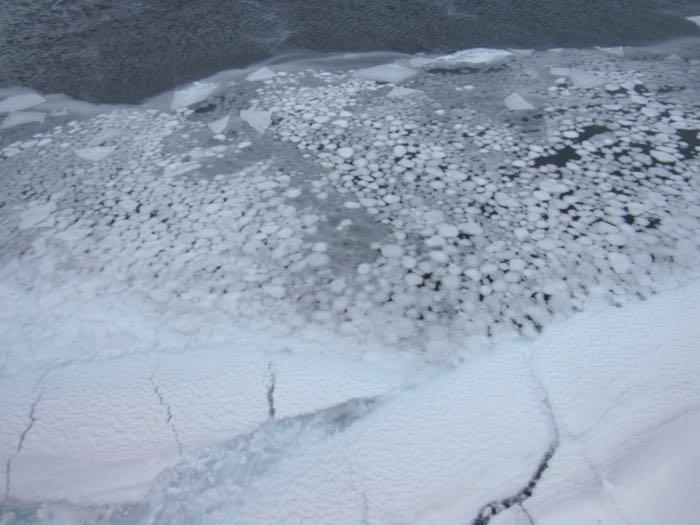
Pancake ice refers to fairly small chunks of ice (no more than a few meters/yards wide). If air temperatures are below freezing, grease ice and frazil ice will continue to freeze. When the water is rough and there are waves, this forms pancake ice. The edges of the ice become rounded as it forms and thickens. Pancake ice is white in color. The pancakes float around in the water near each other, until colder temperatures or calmer waters allow them to freeze together.
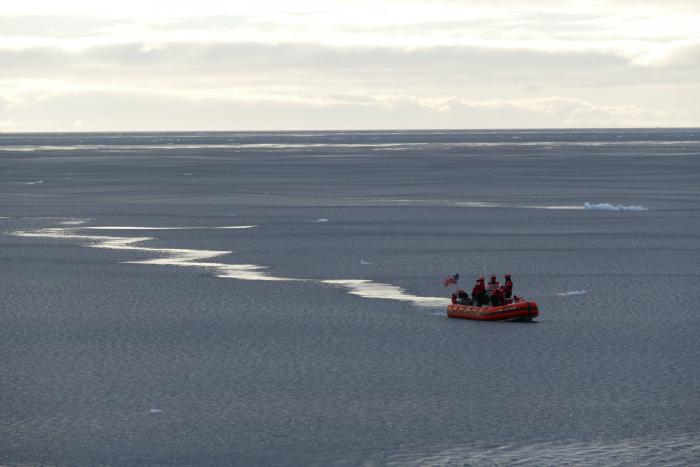
Nilas ice forms as grease/frazil ice continues to freeze in calm waters. It is thin and clear. It can create much wider slabs than pancake is since it forms in water without big waves. Winds and water currents can push pieces of nilas ice on top of each other. This forms beautiful patterns.
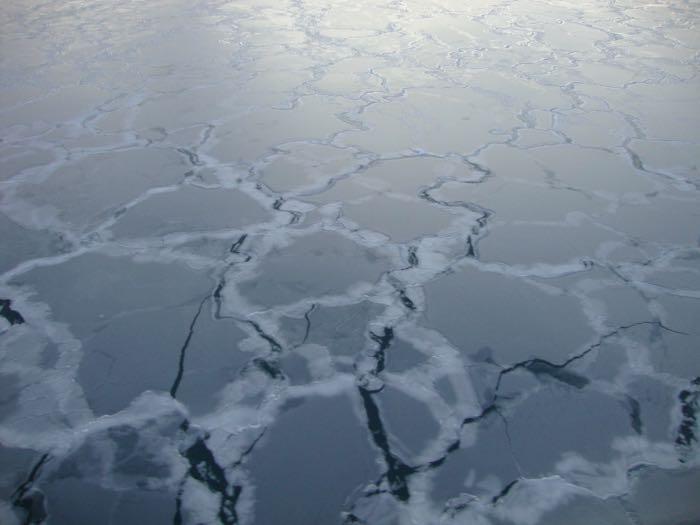
Those are examples of young sea ice. There are also many types of first-year, second-year, and multi-year sea ice. First year ice is usually less than half a meter (1-2 feet) thick and is mostly called white, grey, or grey-white ice. Check out the Ice Watch program website for way more photos and definitions.
Now it is time to test your Ice Watch skills! I'll add more photos after the expedition, but for now here are two to try out. Estimate ice concentration, and if you can, describe the type. You can try thickness, but this is hard without having any scale with the observation. Answers will be at the very end of this journal.
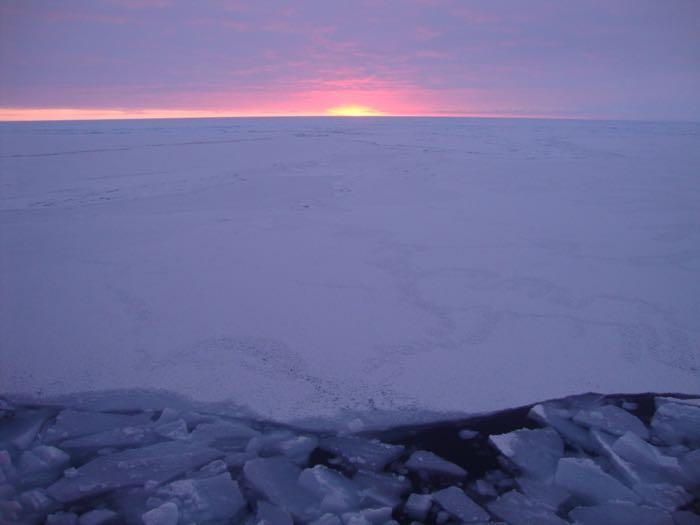
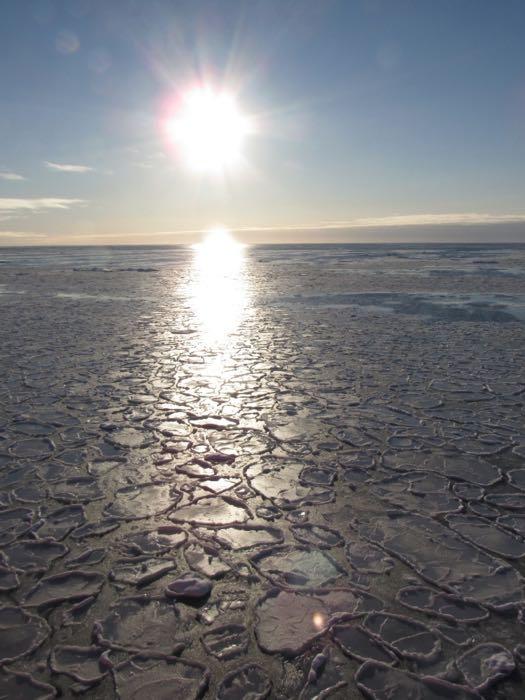
Word of the Day
Snego in Russian translates into English snow. Similarly, snegokhod is used to refer to a snowmachine/snowmobile.
Yesterday I shared with you that led is the Russian word for ice. Today, we got an updated spelling that it might be better to use lyod. Because Russian is written in Cyrillic, sometimes it is a challenge to translate into Roman letters.
Your Questions and Curiosities: Sounds of Ice
Thorey from Homer, Alaska asks: "What does the ice SOUND like when you're frozen in and drifting?" This is an excellent question. The sea ice has many different sounds. Generally, it is much louder when the icebreaker is moving through it and fracturing the ice. When we encounter thicker pieces of ice, there is a dull booming sound as the hull collides with these chunks of ice. We feel a shake and shudder on the ship, almost like airplane turbulence. When the broken chunks of ice rub against the side of the ship, there is a distinctive soft sliding scraping sound. It reminds me a lot of warm winter days when chunks of icy snow melt enough on our metal roof to slide down the incline. If you don't have a metal roof but want to hear something similar, take some icy snow and put it down a metal playground slide. And if you don't have snow around, maybe you could use a sno-cone (without any flavoring added). Right now the Fedorov has stopped and is drifting with the ice as they do helicopter and snowmachine surveys of the ice floes. Our path through the ice has quickly refrozen, so I suppose we are sort of 'frozen in' but not as much as the Polarstern will be. We don't hear many sounds from the ice when we are drifting with it. If wind or currents pushed floes of ice into or onto each other, I'm sure we would hear some of the scraping or grinding sounds. I'm curious what it would sound like if a lead (crack) opened up near the ship. I'll have to ask people on Polarstern. At some point during their year in the ice, this is likely to happen.
Education Extension
There are many ways to observe and understand sea ice. If you live in a region with sea ice, consider adding observations of sea ice formation and melt or unusual situations to LEO (Local Environmental Observers) Network. This is also a great tool for documenting and sharing information about any environmental observations, not just sea ice. With a great map interface that you can filter by topic, it is a fantastic source for qualitative data and information that learners can use to investigate change in the Arctic and beyond. Much appreciation to the Alaska Native Tribal Health Consortium for leading this program!
GLOBE (Global Learning and Observations to Benefit the Environment) is a NASA project that uses community-based monitoring to validate and improve satellite observations. Though there is no sea ice program through GLOBE, there are protocols for measuring snow depth over time. Being able to differentiate snow depth from ice depth in the Arctic is critical to accurate sea ice measurements, predictions, and climate models. If you live in an area that receives snow, you and your students can make measurements that will help NASA to better understand how well their satellite remote sensing measures snow depth -- and how to improve it.
In addition to community-based monitoring and remote sensing via satellites, researchers work onsite themselves or deploy a variety of equipment. In this engineering design challenge for elementary students, students learn about sea ice and sea ice observation technology to build and design their own sea ice drifter.
Ice Watch Quiz Answers:
1) 10/10 concentration. I think it is young white sea ice. My best guess for thickness based on the chunks broken by the ship is 10-30 centimeters (about 1 foot).
2) 10/10 concentration. You've seen this photo before, so you know it is mostly pancake ice. I would call this 8/10 concentration of cemented pancake ice and maybe 2/10 concentration of young grey ice. But I'm still learning this whole Ice Watch thing!

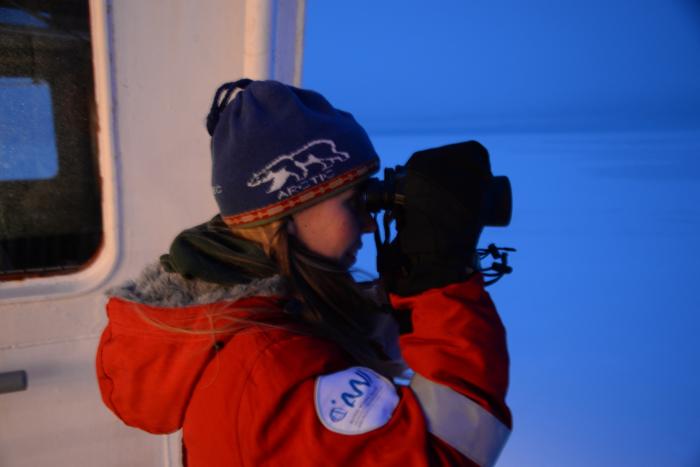

Comments